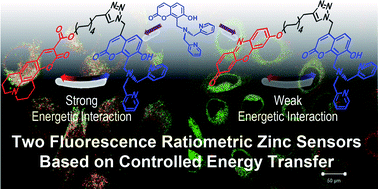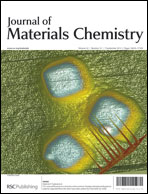The high-fidelity detection of labile zinc is of central importance for understanding the molecular mechanisms that link zinc homeostasis and human pathophysiology. Fluorescence ratiometric sensors are most suitable for the detection and trafficking of intracellular zinc ions. Here, we report the development of fluorescence ratiometric zinc sensors (HN1 and HN2) based on two-fluorophore platforms. The sensor constructs include blue fluorescent umbelliferone and an energy-accepting chromophore that absorbs the blue fluorescence. Zinc binding was found to promote fluorescence turn-on of the umbelliferone emission by suppression of intramolecular photoinduced electron transfer, thereby facilitating resonance energy transfer to the energy acceptors. The net observables were the fluorescence ratiometric changes, the extent of which depended strongly on the chemical structures of the acceptors. Photophysical investigations, including steady-state and transient photoluminescence spectroscopy, suggested a mechanism for the fluorescent zinc response that involved a combination of the intramolecular electron transfer and the interchromophoric energy transfer. The zinc probes displayed sensing capability that is suitable for the detection of biological zinc ions, with good selectivity, pH tolerance, and appropriate Kd values. Finally, zinc detection was demonstrated by fluorescence ratiometric visualization of exogenously supplied zinc ions in live HeLa cells. The probes enabled the reliable monitoring of zinc equilibration across the cell membrane.

You have access to this article
 Please wait while we load your content...
Something went wrong. Try again?
Please wait while we load your content...
Something went wrong. Try again?


 Please wait while we load your content...
Please wait while we load your content...